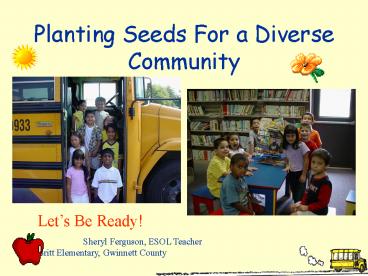Planting Seeds For a Diverse Community - PowerPoint PPT Presentation
1 / 25
Title:
Planting Seeds For a Diverse Community
Description:
Planting Seeds For a Diverse Community Let s Be Ready! Sheryl Ferguson, ESOL Teacher Britt Elementary, Gwinnett County – PowerPoint PPT presentation
Number of Views:95
Avg rating:3.0/5.0
Title: Planting Seeds For a Diverse Community
1
Planting Seeds For a Diverse Community
Lets Be Ready! Sheryl
Ferguson, ESOL Teacher
Britt Elementary, Gwinnett
County
2
As we become more diverse, we can choose for our
diverse population to become a burden or we can
choose to help them become an asset.
3
When you get your ELL students
- Learn to pronounce their names.
-Learn about their
backgroundsWhy are they
here for a better life, for a job, business
transfer or promotion, for life?
4
When you get your ELL students
- Pay attention to social and cultural customs.
- Use the same language We are going
to the playground. OR We are going outside.
5
When you get your ELL students
- Assign a willing friend and helper.
-Choose small groups rather than large groups.
6
Remember how language develops!
- First Listening
- Second Speaking
- Third Reading
- Fourth Writing
7
Where are your students?
- Level 1 - quiet, minimal comprehension
listening! - These students can
- listen, draw, point, copy, act, match, circle,
color!
8
Where are your students?
- Level 2 - Increased comprehension, 1-2 word
sentences - These students can
- -name, list, label, group, tell, say,
respond, answer!
9
Where are your students?
- Level 3 - Increased comprehension, simple
sentences, errors in speech - These students can
- -recall, retell, describe, summarize,
role-play, compare, contrast!
10
Where are your students?
- Level 4 good comprehension, more complex
sentences, complex errors in speech, engages in
conversation. - These students can
- -analyze, create, evaluate,
- justify, support, debate!
- Theyre ready for transition!
11
Teaching ELL students is simply good teaching!
- Tell me and I will forget.
- Show me and I will remember.
- Involve me and I will understand!
12
Find your students and meet them where they are.
- All cultures do not think, believe, or learn in
the same way.
- Home cultures may not have prepared students
for interacting in their school community.
- Financial difficulties may interfere with
home/school involvement.
13
Children construct their own understanding of
the world.
- It is the teachers job to create appropriate
learning contexts so students can construct, and
take responsibility for, their own understanding
of concepts.
14
Teachers must be willing to
- Think flexibly.
- Explicitly connect school learning to childrens
own life experiences.
- Differentiate between cognitive skills and social
and cultural context in which the academic skills
are set.
15
ELL students ARE at risk!
- The challenge for teachers is to accommodate
these students needs in classrooms where, in the
end, all students must learn to work confidently,
productively, and successfully.
16
What are your students learning modalities?
- Visual
- Auditory
- Kinesthetic
17
Students learn best in classrooms that are
student centered, with the teacher in the role of
the facilitator! You dont always have to be the
teacher!
18
Make learning meaningful!
Story Retelling
Rich Illustrations or Photos
Hands-On
19
Make learning meaningful!
Create!
Totally Physical!
Sing! Dance! Role Play!
20
Teachers must
- Model Academic Language!
Think Aloud!
Love Your Children!
Scaffold Lessons! Introduce Key Vocabulary!
21
NEP Parent Communication
Save your students work in a portfolio!
- Photographs tell a story in all languages!
22
Planting Seeds For a Diverse Community.
- Accept our diversity!
23
Planting Seeds For a Diverse Community.
- Celebrate our differences!
24
Planting Seeds For a Diverse Community.
- These students did not chose to learn a second
language. Plant their seeds so they may become an
asset to our school,to our community to our
country!
25
Now go and plant your seeds for our future!































